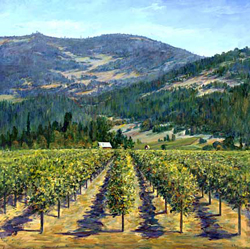Lectures
Lecture 2: Exploration and Conquest

The Spanish exploration of California began in 1542, when Juan Rodriguez Cabrillo was asked by the government of Spain to find a passage to Asia. He and his expedition sailed up the coast from Mexico, discovering the San Diego Bay and the San Pedro Bay. The sailed as far north as the Russian River before turning back.
Then the Spanish decided that the coast of California might serve as a useful supply station for the galleons that sailed to the Philippines. A number of explorers tried to find a suitable harbor but failed, and the Spanish lost interest in California for the next 150 years.
But in the 1700s, when they discovered that the Russians, who had been exploring and colonizing the Pacific Northwest, were planning to extend their influence further south, they decided to explore, colonize, and establish dominance over the area they called "Alta California." They appointed Gaspar de Portola to head the military branch of the operation, and Father Junipero Serra to head the missionary branch. The Spanish devised a system combined of presidios (military forts), missions (churches and religious communities), pueblos (centers of civilian activity) and rancheros (ranches and farms). If you went to elementary school in California, you probably studied the missions during your 4th grade year: their importance in California history is hard to underestimate. Most of the large cities that exist in California began as missions or pueblos.
The first mission to be built was in San Diego in 1769; from there, Serra and de Portola moved north, founding 21 missions over the next 12 years. Click HERE to see a map of the California Missions.
Those Europeans who explored and later settled California during the late 1700s and early 1800s didn't have much time to write poetry, plays, and short stories. They wrote little, and what they did write was nonfiction: travel writings, diaries, and reports. Nevertheless, their words give us insight into what that time was like.
The goal of the Spanish was to lay claim to the land and any of its useful resources, to explore it and map it, and to bring its native inhabitants into the Catholic Church. Thus, soldiers and navigators were teamed with priests.
It is important to remember that the men who led these expeditions were deeply committed to their religion. In the name of that religion, and in the service of economic conquest, many California Indians were killed, and their way of life was destroyed. But the men who did these things, for the most part, believed they were necessary to save the souls of the Indians. The Spanish saw disorder, chaos, and lack of religion when they looked at the Indians; they believed they were civilizing infidels. Such an intolerant attitude is hard to stomach in our time, but it was never questioned then, either in California or in any other parts of the world colonized by Europeans.
As the land was mapped and brought under the control of the presidios and missions, pueblos and rancheros were built; these formed the basis of towns which grew larger and larger as time passed. More and more people moved into California from Mexico as the Spanish extended their influence, until the Indians had largely been displaced by Hispanic settlers, farmers, and ranchers. They created an extensive agricultural industry, and were known as "Californios."
After Mexico won its war for independence from Spain in 1821, the missions were decommissioned and even more land became ranches; the ports were opened to international trade. As California began to trade with the United States, more and more people began to move in. The first overland expedition from the east was led by Jedediah Smith in 1826, from Salt Lake City to San Diego. By 1835, President Andrew Jackson had begun thinking seriously about acquiring California as a state, and by the 1840s, the number of Anglo Americans migrating to California had increased dramatically. They began to encroach on the lands of the Californios, and there were bitter clashes.
After the Mexican-Amertican War ended in 1848, the Treaty of Guadalupe Hidalgo was signed; one of its provisions was that 525,000 square miles of Mexican territory, including California, would be ceded to the United States in exchange for 15 million dollars. The treaty specifically stated that the property rights of the existing Mexican landowners would be protected. But this provision was seldom honored, and many families' lands were stolen from them by Anglo ranchers. The last military governor of California, Mariano Guadalupe Vallejo, wrote bitterly in his journal,
The language now spoken in our country, the laws which govern us, the faces we encounter daily, are those of the masters of the land and, of course, antagonistic to our interests and rights, but what does that matter to the conqueror? He wishes his own well-being and not ours!--a thing that I consider only natural in individuals, but which I condemn in a government which has promised to respect and make respected our rights, and treat us as its own sons. But what does it avail us to complain? The thing has happened and there is no remedy.
The same could have been written by the Indians, a hundred years before.
If you'd like more information on any of the topics covered in this lecture, go to the Links page. Enjoy!
The information in this lecture is derived in part from the following sources:
~The Literature of California, Jack Hicks
~Many Californias, Gerald W. Haslam
One of the things I had a hard time getting used to when I came to California in '78 was Santa Claus in shorts.
~ Dennis Franz
